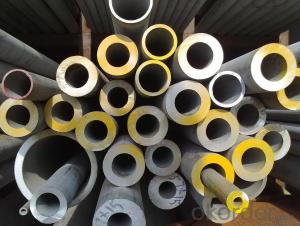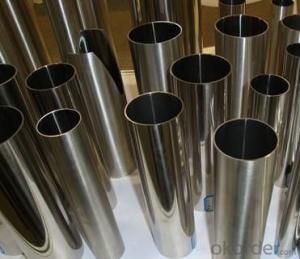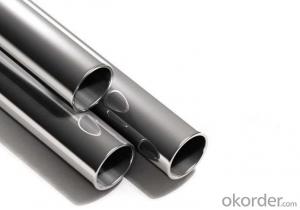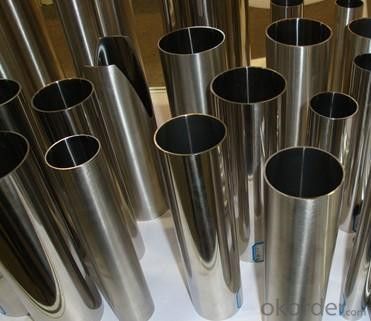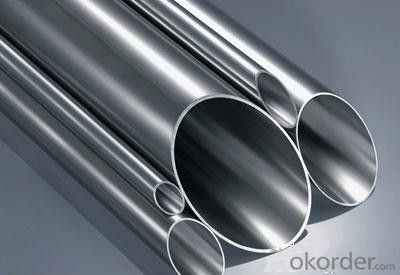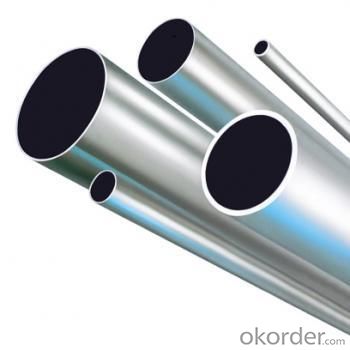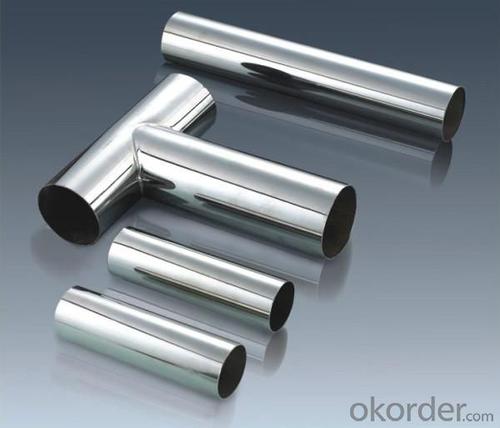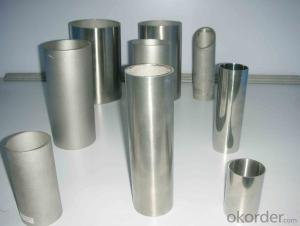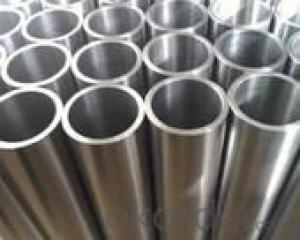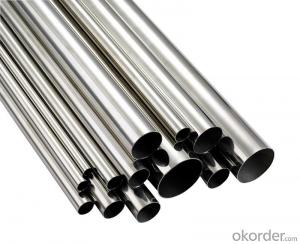316 Stainless Steel Pipe
- Loading Port:
- China main port
- Payment Terms:
- TT OR LC
- Min Order Qty:
- 5 m.t.
- Supply Capability:
- 100000 m.t./month
OKorder Service Pledge
OKorder Financial Service
You Might Also Like
Specification
SPECIFICATION
Stainless Steel Pipe:
1. 201, 202, 301, 304, 316L, 430, etc
2. OD: 6mm-159mm
3. Thickness: 0.25mm-3.5mm
4. Finish: Mirror, Satin, Hairline
316 STAINLESS STEEL PIPE:
Name | 316 Stainless steel pipe | |||||
Standard | ASTM A554,ASTM A312 | |||||
Material Grade | 201,202,304,316,316L,430 | |||||
Main Material
| a) 201 (Ni0.8%-1%) b) 202 (Ni: 3.0%-4.0%) d) 316 (Ni: 10% Cr: 18%) | |||||
Size Range | 139mm-1600mm ETC. | |||||
Thickness | 0.5-30mm | |||||
Length | 6m or as customers' request | |||||
Tolerance | a) Outer Diameter: +/- 0.2mm | |||||
b) Thickness: +/- 0.02mm | ||||||
c) Length: +/- 5mm | ||||||
Surface | 180G, 320G Satin/Hairline 400G, 600G Mirror finish | |||||
Application | handrail,railing, staircase, weldmesh screen,door,window, balcony,fence,bench,furniture,etc | |||||
Test | Squash test, extended test, water pressure test, crystal rot test, heat treatment, NDT | |||||
Chemical Composition of Material | 201 | 202 | 304 | 316L | 430 | |
C | ≤0.15 | ≤0.15 | ≤0.08 | ≤0.035 | ≤0.12 | |
Si | ≤1.00 | ≤1.00 | ≤1.00 | ≤1.00 | ≤1.00 | |
Mn | 5.5-7.5 | 7.5-10 | ≤2.00 | ≤2.00 | ≤1.00 | |
P | ≤0.06 | ≤0.06 | ≤0.045 | ≤0.045 | ≤0.040 | |
S | ≤0.03 | ≤0.03 | ≤0.030 | ≤0.030 | ≤0.030 | |
Cr | 13-15 | 14-17 | 18-20 | 16-18 | 16-18 | |
Ni | 0.7-1.1 | 3.5-4.5 | 8-10.5 | 10-14 | ||
Mo | 2.0-3.0 | |||||
Mechanical Property | Material Item | 201 | 202 | 304 | 316 | |
Tensile Strength | ≥535 | ≥520 | ≥520 | ≥520 | ||
Yield Strength | ≥245 | ≥205 | ≥205 | ≥205 | ||
Extension | ≥30% | ≥30% | ≥35% | ≥35% | ||
Hardness (HV) | <105< span=""> | <100< span=""> | <90< span=""> | <90 | ||

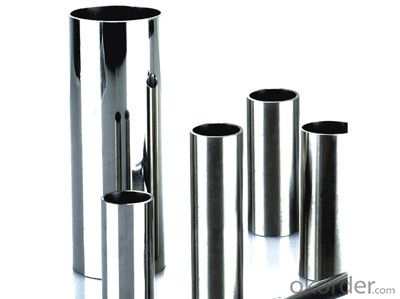
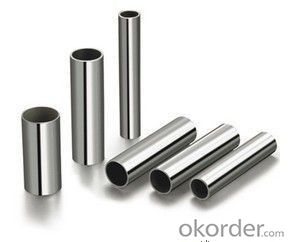
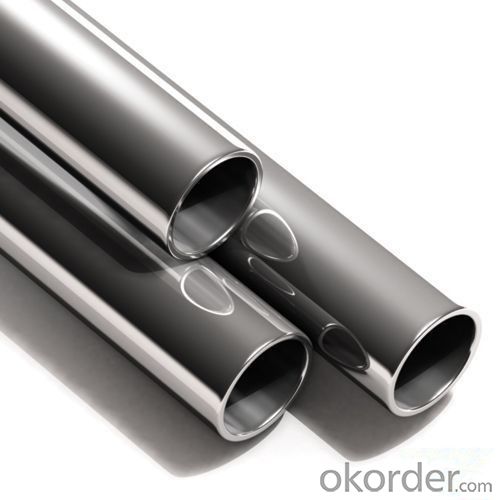
- Q: What's the difference between stainless steel 302 and 304?
- 302 stainless steel and 304 stainless steel are suitable for food processing, storage and transportation. It has good processability and weldability.
- Q: Are stainless steel pipes suitable for gas distribution systems?
- Yes, stainless steel pipes are suitable for gas distribution systems. Stainless steel is known for its high corrosion resistance and strength, making it an ideal material for transporting gas safely and efficiently. It can withstand high pressures and temperatures, ensuring the integrity of the gas distribution system. Additionally, stainless steel pipes have excellent durability and longevity, reducing the need for frequent replacements and maintenance.
- Q: Can stainless steel pipes be used in underground installations?
- Yes, stainless steel pipes can be used in underground installations. Stainless steel is a highly durable and corrosion-resistant material, making it suitable for underground applications where the pipes are exposed to moisture and other environmental factors. Additionally, stainless steel pipes have high strength and can withstand pressure, making them a reliable choice for underground installations.
- Q: What is the difference between Schedule and Nominal Pipe Sizes for stainless steel pipes?
- Schedule and Nominal Pipe Sizes are both used to describe stainless steel pipes, but they refer to different aspects of the pipe. Schedule refers to the wall thickness of the pipe and is denoted by a number. It is a standardized system used to categorize pipes based on their wall thickness. The schedule number indicates the thickness of the pipe in relation to its diameter. For example, a Schedule 40 pipe has a thicker wall than a Schedule 10 pipe of the same diameter. The higher the schedule number, the thicker the wall. On the other hand, Nominal Pipe Size (NPS) refers to the approximate inner diameter of the pipe and is expressed in inches. NPS is a non-dimensional size designation that does not correspond directly to the actual dimensions of the pipe. It is used as a convenient reference for pipe identification and is often used in conjunction with the schedule number to specify a particular pipe. In summary, the main difference between Schedule and Nominal Pipe Sizes for stainless steel pipes lies in what they describe. Schedule indicates the wall thickness, while Nominal Pipe Size refers to the approximate inner diameter of the pipe. Both are important factors to consider when selecting the appropriate stainless steel pipe for a specific application.
- Q: Stainless steel seamless steel tube, ordinary seamless steel pipe, which is good?
- Stainless steel pipe in the nickel element is relatively high, nickel is pipe rust proof, wear-resistant, mainly corrosion-resistant. The strength of the steel pipe is generally related to the content of carbon in the pipe. The ordinary steel pipe is carbon steel pipe, and the compressive strength is generally better than that of the stainless steel tube.
- Q: Can stainless steel pipes be used for ornamental purposes?
- Yes, stainless steel pipes can be used for ornamental purposes. Stainless steel is a versatile material that offers a sleek and modern aesthetic, making it well-suited for decorative applications. The durability and corrosion resistance of stainless steel also make it an excellent choice for outdoor installations or in humid environments where other metals might deteriorate over time. Stainless steel pipes can be fabricated into various shapes and sizes, allowing for creative and visually appealing designs. They are commonly used in architectural structures, such as railings, handrails, and balustrades, as well as in decorative furniture, lighting fixtures, and artwork. Additionally, stainless steel pipes can be polished or finished in different ways to enhance their appearance and create a desired decorative effect. Overall, stainless steel pipes provide a durable and visually pleasing solution for ornamental purposes.
- Q: Can stainless steel pipes be insulated with polybutylene?
- Polybutylene, a plastic material frequently utilized for water supply pipes, is not viable for insulating stainless steel pipes. These pipes, already remarkably corrosion-resistant, do not necessitate additional insulation for thermal purposes. In the event that insulation becomes essential for stainless steel pipes, alternative materials like fiberglass or foam pipe insulation may be employed.
- Q: What is the difference between electropolished and bright annealed stainless steel pipes?
- Two distinct surface treatments are applied to stainless steel pipes in order to enhance their properties and appearance: electropolishing and bright annealing. Electropolishing, an electrochemical process, eliminates a thin layer of material from the stainless steel pipe's surface. This procedure eradicates any impurities, contaminants, or roughness, resulting in a polished and smooth finish. Additionally, electropolishing bolsters the stainless steel's resistance to corrosion by generating a passive oxide layer on the surface, which safeguards the underlying material against corrosion. On the contrary, bright annealing is a heat treatment process involving heating the stainless steel pipe to a precise temperature and gradually cooling it under controlled conditions. This technique alleviates internal stresses, enhances the material's ductility and toughness, and improves its mechanical properties. Bright annealing also produces a smooth and reflective surface finish comparable to electropolishing, but without the electrochemical removal of material. In conclusion, the primary discrepancy between electropolished and bright annealed stainless steel pipes lies in the methods employed to achieve the desired surface finish. Electropolishing entails removing material through an electrochemical process, whereas bright annealing is a heat treatment process that yields a smooth and reflective surface without material removal. Both treatments enhance the appearance and corrosion resistance of stainless steel pipes, but bright annealing also elevates the material's mechanical properties.
- Q: What is the impact strength of stainless steel pipes?
- Stainless steel pipes possess a generally high impact strength, rendering them resistant to cracking or breaking when subjected to applied force or impact. The exceptional toughness of stainless steel, characterized by its capacity to absorb energy and deform without fracturing, is widely acknowledged. This characteristic is attributable to the microstructure of stainless steel, which comprises a combination of austenite and ferrite phases. The presence of these phases grants stainless steel pipes superior impact resistance in comparison to other materials. The impact strength of stainless steel pipes varies depending on the specific grade or alloy employed. For example, austenitic stainless steels, such as grades 304 and 316, are renowned for their remarkable impact strength. Due to their ability to endure impact loads without failure, these grades are extensively utilized in various industries, including construction, oil and gas, and chemical processing. Moreover, the impact strength of stainless steel pipes can be further bolstered through different heat treatment procedures, such as tempering or quenching. These processes alter the microstructure of the steel, resulting in improved mechanical properties, including enhanced toughness and impact resistance. In conclusion, stainless steel pipes possess robust impact strength, making them highly suitable for applications that necessitate resistance to impact or shock loading. The ability of these pipes to withstand substantial forces without fracturing or breaking guarantees their longevity and dependability across diverse industries.
- Q: What is the external insulation used for stainless steel pipes?
- Various materials like mineral wool, fiberglass, or foam are commonly utilized for the external insulation of stainless steel pipes. These insulating materials are applied to the outer surface of the pipes, serving the purpose of thermal insulation and safeguarding against heat loss or gain. By doing so, the insulation aids in sustaining the desired temperature of the fluid or substance flowing through the pipes, thereby preventing condensation and minimizing energy loss. Moreover, the external insulation acts as a barrier against corrosion and mechanical harm, guaranteeing the durability and effectiveness of the stainless steel pipes.
Send your message to us
316 Stainless Steel Pipe
- Loading Port:
- China main port
- Payment Terms:
- TT OR LC
- Min Order Qty:
- 5 m.t.
- Supply Capability:
- 100000 m.t./month
OKorder Service Pledge
OKorder Financial Service
Similar products
Hot products
Hot Searches
Related keywords
